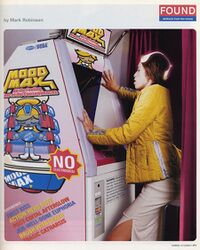Difference between revisions of "References to Sega/Art"
From Sega Retro
(Created page with "{{back}} The following is a list of '''references to Sonic in art'''. ==Digital art== {| class="prettytable sortable" !Artist !Date !Description !width="200px"|Images |-...") |
m |
||
| Line 1: | Line 1: | ||
{{back}} | {{back}} | ||
| − | The following is a list of '''references to [[ | + | The following is a list of '''references to [[Sega]] in art'''. |
| + | |||
| + | For references specific to [[sonic:Sonic the Hedgehog|Sonic the Hedgehog]], see [[sonic:References to Sonic in art|References to Sonic in art]]. | ||
==Digital art== | ==Digital art== | ||
Revision as of 19:23, 17 November 2024
- Back to: References to Sega.
The following is a list of references to Sega in art.
For references specific to Sonic the Hedgehog, see References to Sonic in art.
Digital art
| Artist | Date | Description | Images |
|---|---|---|---|
| Mark Robinson | 2004 | For Wired's annual "Artifacts from the future" piece in 2004, magazine editor Mark Robinson created a photograph of an imaginary future arcade machine. Envisioned as the result of a fictional collaboration between Japanese Sega Enterprises, Ltd. and the American pharmaceutical company Pfizer, Mood Max parodies the perceived ease of access of pharmaceutical medication - and the emotions they can replace - in the modern world.[1] | 
|
References
- ↑ https://futuryst.blogspot.com/2008/07/compleat-wired-future-artifacts-gallery.html (Wayback Machine: 2024-07-14 05:49)